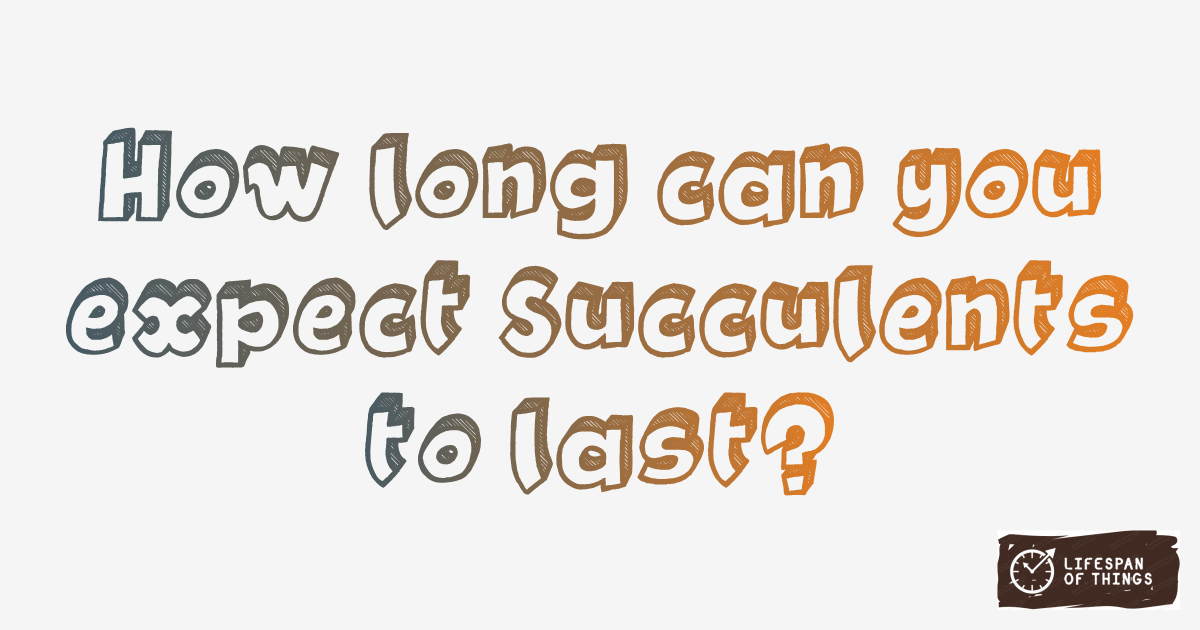
5 - 10 Years
Lifespan of Succulents is 5 - 10 Years. Succulents thrive in arid environments and require minimal water. Factors like soil quality, sunlight exposure, and proper drainage affect their longevity. Regular pruning and repotting can help extend their lifespan.
Useful Information
Succulents naturally thrive in dry, well-drained soil with plenty of sunlight. They are ideal for indoor environments and do not require frequent watering. Adequate sunlight and occasional fertilization are key to their growth and longevity.
Succulents contribute to air quality by absorbing carbon dioxide and releasing oxygen. Their shallow roots prevent soil erosion and aid in water conservation. These low-maintenance plants are eco-friendly choices for indoor and outdoor spaces.
Succulents are popular for home decor, terrariums, and landscaping due to their unique shapes and colors. Some varieties have medicinal properties while others are used in cosmetic products. They are versatile plants that can be creatively incorporated into various crafts and DIY projects.
Discover the decorative uses of houseplants in interior design, including adding color, texture, and natural elements to your living spaces. Read more
Conservation efforts focus on preserving rare succulent species and their habitats. Overwatering, habitat destruction, and illegal harvesting pose threats to their survival. Supporting sustainable cultivation and raising awareness about their cultural and ecological importance are essential for their protection.
Notable examples of succulents include the Sempervivum 'Hens and Chicks' known for its rosette-like clusters, and the Aloe Vera plant prized for its healing properties. The Giant Barrel Cactus is an iconic succulent found in desert landscapes, symbolizing resilience in harsh environments.
Lifespan Comparisons
| Compared Item | Comparison Description |
|---|---|
| Lifespan of Flowering Plants | Succulents have a longer lifespan compared to Flowering Plants, lasting 2-5 years more on average. |
| Lifespan of Foliage Plants | When it comes to lifespan, Succulents are similar to Foliage Plants, with comparable longevity of 5-10 years. |
| Lifespan of Air Plants | Air Plants have a shorter lifespan than Succulents by approximately 2-5 years. |
| Lifespan of Exotic Houseplants | Compared to Exotic Houseplants, Succulents tend to last longer by around 2-5 years. |
| Lifespan of Snake Plant | Both Snake Plant and Succulents share a similar lifespan range of 5-10 years. |
| Lifespan of Spider Plant | Spider Plants generally have a shorter lifespan than Succulents, lasting around 2-5 years on average. |
| Lifespan of ZZ Plant | ZZ Plant has an exceptional lifespan of 50-100 years, surpassing Succulents by a significant margin. |
| Lifespan of Dieffenbachia | Dieffenbachia and Succulents have a similar lifespan range of 5-10 years, making them long-lasting choices for indoor plants. |
| Lifespan of Antiseptics | While Succulents last around 5-10 years, Antiseptics have a slightly shorter lifespan of 3-7 years on average. |
| Lifespan of Ancient Tools | Archaeological Relics endure for centuries, contrasting with the shorter lifespan of Succulents. |
| Lifespan of Manuscripts and Texts | Manuscripts and Texts have a lifespan ranging from 100-300 years, much longer than Succulents. |
| Lifespan of Archaeological Relics | In comparison to the long-lasting Archaeological Relics, Succulents have a relatively shorter lifespan of 5-10 years. |
| Lifespan of Artistic Artifacts | Artistic Artifacts share a similar lifespan range with Succulents, lasting around 5-10 years. |
| Lifespan of Historical Weapons | Historical Weapons outlast Succulents by approximately 40-95 years, with a lifespan range of 50-100 years. |
| Lifespan of Festivals | Festivals typically last 3-5 years, differing greatly in lifespan from the enduring Succulents. |
Frequently Asked Questions
Lifespan of Succulents is 5 - 10 Years.
Proper care for your Succulents includes providing adequate sunlight, well-drained soil, and occasional pruning to promote longevity.
Succulents contribute to air quality by absorbing carbon dioxide, preventing soil erosion, and aiding in water conservation, making them eco-friendly indoor plants.
Succulents have medicinal properties, are used in cosmetic products, and can be creatively incorporated into crafts and DIY projects for versatile applications.
You can support conservation efforts by raising awareness about their importance, avoiding overwatering, and promoting sustainable cultivation practices.
Notable examples include the Sempervivum 'Hens and Chicks', Aloe Vera plant, and Giant Barrel Cactus, each known for their unique characteristics and uses.








